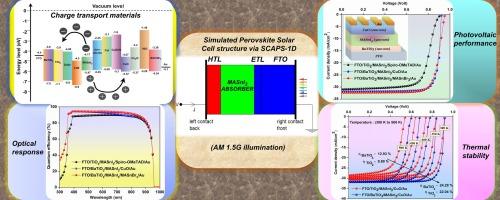基于SCAPS-1D的各种ETL/HTL工程MASnI3平面钙钛矿太阳能电池结构的计算建模和光伏性能评估
IF 10.9
1区 工程技术
Q1 ENERGY & FUELS
引用次数: 0
摘要
钙钛矿太阳能电池(PSCs)是一种走向商业化的前沿光伏技术。为了处理效率和可持续性之间的权衡,本报告概述了利用太阳能电池电容模拟器(SCAPS-1D)软件设计基于碘化甲基铵锡(MASnI3)本质吸收剂的平面PSC,并设计了新型电荷传输材料。为了超越传统的TiO2/MASnI3/Spiro-OMeTAD PSC,采用了3种电子输运材料(ETMs)和6种空穴输运材料(HTMs)。共配置了21个psc,其效率在14.28% ~ 24.28%之间。值得注意的是,这是首次展示多功能钙钛矿氧化物钛酸钡(BaTiO3)作为MASnI3 PSC中可行的ETM的研究。为了理解漂移扩散特性,系统分析了带偏置、层厚、掺杂浓度、扩散长度、量子效率、内置电位、电流密度-电压(J-V)分布、Mott-Schottky、阻抗和暗J-V特性等关键因素。在BaTiO3/MASnI3界面处,优良的介电常数、良好的附着力、高的复合电阻和强电场改善了填充系数、效率和输出功率。同时,对HTMs的活化能进行了评价,发现CuO、MASnBr3的活化能明显不同。此外,还评估了温度、背触点、串联(Rs)和分流(Rsh)电阻对最佳PSC配置的影响。所提出的PSC结构FTO/BaTiO3/MASnI3/CuO/Au和FTO/BaTiO3/MASnI3/MASnBr3/Au具有热稳定性,并表现出Rs和Rsh的平衡相互作用,效率分别为24.28%和24.09%。这些研究成果将使实验室规模的psc的制造成为可能,并为未来的大规模实施铺平道路。本文章由计算机程序翻译,如有差异,请以英文原文为准。

Computational modelling and photovoltaic performance evaluation of various ETL/HTL engineered MASnI3 planar perovskite solar cell architectures using SCAPS-1D
Perovskite solar cells (PSCs) are the cutting-edge photovoltaic technology heading towards commercialization. To deal with the trade-off between efficiency and sustainability, this report outlines the utilisation of solar cell capacitance simulator (SCAPS-1D) software to design methyl ammonium tin iodide (MASnI3) intrinsic absorber based planar PSC having engineered with novel charge transport materials. To outperform the conventional TiO2/MASnI3/Spiro-OMeTAD PSC, three electron transport materials (ETMs) and six hole transport materials (HTMs) were employed. Twenty-one PSCs were configured, whose efficiencies vary between 14.28% and 24.28%. Notably, this is the first research to showcase the multifunctional perovskite oxide Barium titanate (BaTiO3) as a viable ETM in MASnI3 PSC. To comprehend the drift–diffusion characteristics, the crucial factors such as band offset, layer thickness, doping concentration, diffusion length, quantum efficiency, built-in-potential, current density–voltage (J-V) profile, Mott-Schottky, impedance and, dark J-V characteristics were systematically analysed. It is believed that, an excellent dielectric constant, good adhesion, high recombination resistance and strong electric field at BaTiO3/MASnI3 interface ameliorate the fill factor, efficiency and, output power. Meanwhile, the activation energy of HTMs were evaluated and found CuO, MASnBr3 to be distinct. Further, the impact of temperature, back contact, series (Rs) and shunt (Rsh) resistances, for the best PSC configurations were assessed. The proposed PSC architectures FTO/BaTiO3/MASnI3/CuO/Au and FTO/BaTiO3/MASnI3/MASnBr3/Au are thermally stable and exhibit a balanced interplay of Rs and Rsh leading to phenomenal efficiencies of 24.28% and 24.09% respectively. These research findings will enable the fabrication of lab-scale PSCs, and pave the way to large-scale implementation in the future.
求助全文
通过发布文献求助,成功后即可免费获取论文全文。
去求助
来源期刊

Energy Conversion and Management
工程技术-力学
CiteScore
19.00
自引率
11.50%
发文量
1304
审稿时长
17 days
期刊介绍:
The journal Energy Conversion and Management provides a forum for publishing original contributions and comprehensive technical review articles of interdisciplinary and original research on all important energy topics.
The topics considered include energy generation, utilization, conversion, storage, transmission, conservation, management and sustainability. These topics typically involve various types of energy such as mechanical, thermal, nuclear, chemical, electromagnetic, magnetic and electric. These energy types cover all known energy resources, including renewable resources (e.g., solar, bio, hydro, wind, geothermal and ocean energy), fossil fuels and nuclear resources.
 求助内容:
求助内容: 应助结果提醒方式:
应助结果提醒方式:


